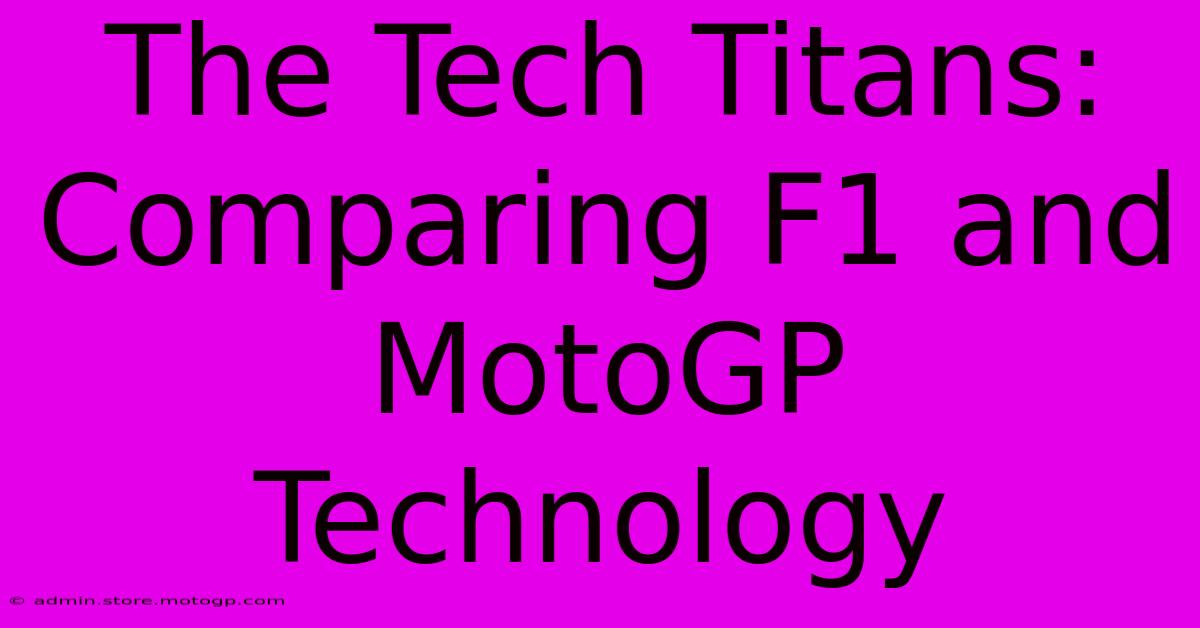The Tech Titans: Comparing F1 And MotoGP Technology

Table of Contents
The Tech Titans: Comparing F1 and MotoGP Technology
Formula 1 and MotoGP. Two pinnacles of motorsport, each pushing the boundaries of engineering and technology. While seemingly disparate on the surface – four wheels versus two – a closer look reveals fascinating parallels and significant differences in their technological approaches. This article delves into the cutting-edge innovations driving these exhilarating sports.
Powertrains: A Tale of Two Engines
The heart of any racing machine is its engine, and here, F1 and MotoGP diverge dramatically. F1 boasts powerful 1.6-liter V6 turbo-hybrid power units, a complex symphony of internal combustion and energy recovery systems (ERS). This hybrid technology, crucial for improving fuel efficiency and performance, showcases the sport's commitment to sustainability while maintaining breathtaking speeds. The ERS cleverly captures energy during braking and cornering, deploying it for short bursts of extra power.
MotoGP, on the other hand, relies on powerful, screaming inline four-cylinder engines with significantly larger displacements, typically around 1000cc. These engines are designed for high-revving performance and raw power, delivering a visceral experience quite distinct from the controlled power delivery of an F1 car. While MotoGP doesn't incorporate hybrid technology in the same way as F1, the quest for efficiency is still paramount, driving innovations in engine design and materials.
Key Differences Summarized:
| Feature | Formula 1 | MotoGP |
|---|---|---|
| Engine Type | 1.6L V6 Turbo-Hybrid | 1000cc Inline-Four |
| Power Delivery | Controlled, assisted by ERS | Raw, high-revving |
| Technology Focus | Hybrid technology, energy recovery | Engine efficiency, high RPM performance |
Aerodynamics: Downforce and Drag
Aerodynamics play a crucial role in both F1 and MotoGP, but their implementation differs considerably. F1 cars utilize elaborate ground effect aerodynamics, generating significant downforce through carefully sculpted underbodies and wings. This allows for higher cornering speeds and stability at immense velocities. The complexity of F1 aero is constantly evolving, with teams employing advanced computational fluid dynamics (CFD) simulations and wind tunnel testing.
MotoGP bikes, while also benefiting from aerodynamic enhancements, are significantly more constrained by size and weight limitations. Their aerodynamic designs focus on reducing drag and improving stability at high speeds, often using winglets and fairings strategically placed to manage airflow. While not generating the same level of downforce as F1 cars, MotoGP aerodynamics are critical for maintaining high speeds and achieving optimal rider control.
Chassis and Suspension: Handling the Beast
The chassis and suspension systems in F1 and MotoGP are tailored to their respective vehicle dynamics. F1 cars use advanced carbon fiber monocoques, providing exceptional stiffness and lightweight construction. Suspension systems are sophisticated, employing advanced hydraulics and adjustable components to fine-tune handling characteristics for varying track conditions.
MotoGP bikes, while also utilizing lightweight materials like aluminum, have a different design philosophy. Their chassis and suspension are designed for agility and responsiveness, allowing riders to quickly change direction and lean into corners. Suspension is crucial for absorbing bumps and maintaining stability, especially given the unpredictable nature of road racing circuits.
Tire Technology: Grip and Performance
Tire technology represents another critical area of innovation. Both F1 and MotoGP utilize specially developed, high-performance tires designed for extreme conditions. Tire compounds, construction, and wear are meticulously studied and optimized for specific track conditions and driving styles. The continuous development of tire technology significantly impacts racing strategies and performance outcomes.
Conclusion: A Technological Arms Race
The technological advancements in F1 and MotoGP are remarkable. While their approaches differ significantly, both sports represent the pinnacle of automotive and motorcycle engineering, pushing boundaries and inspiring innovation across various industries. The constant drive for performance improvements guarantees that the technological rivalry between these titans will continue for years to come. The comparison between these two incredibly advanced motorsports highlights the constant evolution and innovation within the fields of engineering and technology. The future promises even more exciting developments and even closer competition.

Thank you for visiting our website wich cover about The Tech Titans: Comparing F1 And MotoGP Technology. We hope the information provided has been useful to you. Feel free to contact us if you have any questions or need further assistance. See you next time and dont miss to bookmark.
Featured Posts
-
How To Give Feedback To Moto Gp Commentators
Feb 19, 2025
-
Experience The Power F1 Concert Performance
Feb 19, 2025
-
Austin F1 Transportation Real Time Updates And Alerts
Feb 19, 2025
-
Moto Gp Live Stream Free Get Your Racing Fix
Feb 19, 2025
-
Witness The Fastest Race On Earth F1 Houston
Feb 19, 2025
